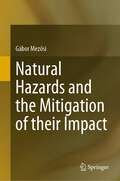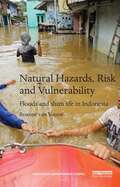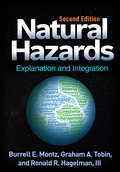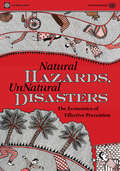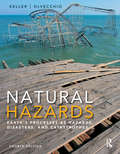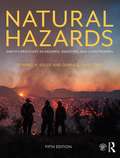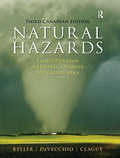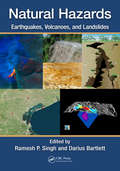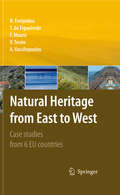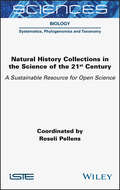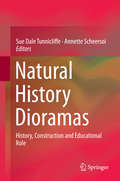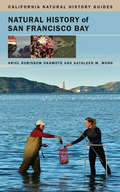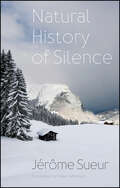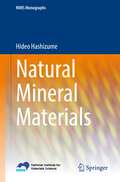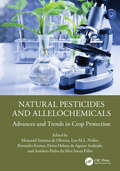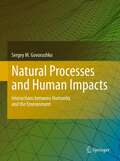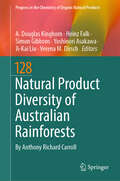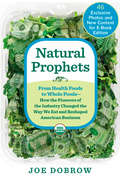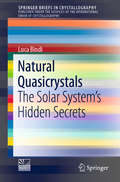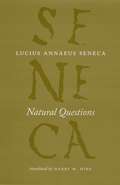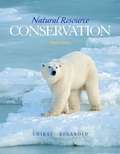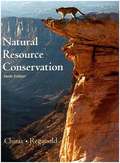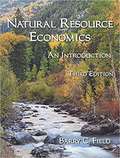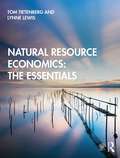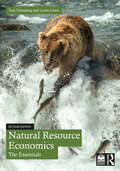- Table View
- List View
Natural Hazards and the Mitigation of their Impact
by Gábor MezősiThis book deals with natural hazards of geophysical, meteorological, hydrological, and biological types that are causing increasing social and economic damage. The development of these hazards and their impact on the living and non-living environment are described in the individual chapters. The compilation synthesises a natural and social geography approach, explores mitigation options and focuses attention on the processes that are most prevalent in Europe and Western Asia, in addition to global phenomena.The author argues that, with the right knowledge and preparedness, the wide-ranging impacts of natural hazards intertwined with climate change can be reduced. This work provides a wealth of digitally accessible professional information to help readers identify and manage natural hazards. The book is useful for students, educators, professionals, practitioners, and those interested in decision making.
Natural Hazards, Risk and Vulnerability: Floods and slum life in Indonesia (Routledge Humanitarian Studies)
by Roanne van VoorstDifferent people handle risk in different ways. The current lack of understanding about this heterogeneity in risk behaviour makes it difficult to intervene effectively in risk-prone communities. Natural Hazards, Risk and Vulnerability offers a unique insight in the everyday life of a group of riverbank settlers in Jakarta - one of the most vulnerable areas worldwide in terms of exposure to natural hazards. Based on long-term fieldwork, the book portrays the often creative and innovative ways in which slum dwellers cope with recurrent floods. The book shows that behaviour that is often described as irrational or ineffective by outside experts can be highly pragmatic and often effective. This book argues that human risk behaviour cannot be explained by the risk itself, but instead by seemingly unrelated factors such as trust in authorities and aid-institutions and unequal power structures. By considering a risk as a lens that exposes these factors, a completely new type of analysis is proposed that offers useful insights for everyone concerned about how people cope with the currently increasing amount of natural hazard. This is a valuable resource for academics, researchers and policy makers in the areas of risk studies, disaster and natural hazard, urban studies, anthropology, development, Southeast Asian studies and Indonesia studies.
Natural Hazards, Second Edition: Explanation and Integration
by Graham A. Tobin Burrell E. Montz Ronald R. Hagelman IIIWhat can we learn from the spatial patterns of disasters? What human and structural factors need to be addressed to explain hazard vulnerability? As populations grow and the climate warms, how can natural hazards be mitigated? Thoroughly revised and updated, and now with a more global perspective, the second edition of this accessible text provides an integrated framework for understanding and managing natural hazards. Numerous case studies from around the world illustrate the complexities of extreme geophysical events and highlight their physical, social, political, and economic dimensions. The text identifies essential principles for tackling the fundamental causes of differential vulnerabilities that perpetuate human distress, and for promoting recovery and resilience. New to This Edition *New frameworks for understanding human resilience and adaptive capacity in recovery, dynamics of risk and uncertainty, and more. *Chapter on spatial and temporal aspects of hazards. *Discussions of cutting-edge topics, such as chronic disasters, controversies in international aid, and how hazards affect regions differentially. *Many new case studies, including Hurricanes Katrina and Charley, Superstorm Sandy, the 2011 Japan tsunami, Ecuador's chronic volcanic hazard, and others. *Reflects 20 years of research advances across the physical and social sciences, development trends, new technologies, and ongoing global climate change.
Natural Hazards, UnNatural Disasters: Effective Prevention Through the Economic Lens
by World BankEarthquakes, droughts, floods, and storms are natural hazards, but unnatural disasters are the deaths and damages that result from human acts of omission and commission. Every disaster is unique, but each exposes actions-by individuals and governments at different levels--that, had they been different, would have resulted in fewer deaths and less damage. Prevention is possible, and this book examines what it takes to do this cost-effectively. It looks at disasters primarily through an economic lens. Economists emphasize self-interest to explain how people choose the amount of prevention, insurance, and coping. But lenses can distort as well as sharpen images, so the book also draws from other disciplines: psychology to examine how people may misperceive risks, political science to understand voting patterns, and nutrition science to see how stunting in children after a disaster impairs cognitive abilities and productivity as adults much later. Peering into the future, it shows that while urbanization and climate change will increase exposure to hazards, vulnerability can be reduced if cities are better managed. This book will be of interest to government officials, urban planners, relief agencies, NGOs, donors, and other development practitioners.
Natural Hazards: Earth's Processes as Hazards, Disasters, and Catastrophes
by Edward A. Keller Duane E. DeVecchioNatural Hazards: Earth Processes as Hazards, Disasters and Catastrophes, Fourth Edition, is an introductory-level survey intended for university and college courses that are concerned with earth processes that have direct, and often sudden and violent, impacts on human society. The text integrates principles of geology, hydrology, meteorology, climatology, oceanography, soil science, ecology and solar system astronomy. The book is designed for a course in natural hazards for non-science majors, and a primary goal of the text is to assist instructors in guiding students who may have little background in science to understand physical earth processes as natural hazards and their consequences to society. Natural Hazards uses historical to recent examples of hazards and disasters to explore how and why they happen and what we can do to limit their effects. The text's up-to-date coverage of recent disasters brings a fresh perspective to the material. The Fourth Edition continues our new active learning approach that includes reinforcement of learning objective with a fully updated visual program and pedagogical tools that highlight fundamental concepts of the text. This program will provide an interactive and engaging learning experience for your students. Here's how: Provide a balanced approach to the study of natural hazards: Focus on the basic earth science of hazards as well as roles of human processes and effects on our planet in a broader, more balanced approach to the study of natural hazards. Enhance understanding and comprehension of natural hazards: Newly revised stories and case studies give students a behind the scenes glimpse into how hazards are evaluated from a scientific and human perspective; the stories of real people who survive natural hazards, and the lives and research of professionals who have contributed significantly to the research of hazardous events.? Strong pedagogical tools reinforce the text's core features: Chapter structure and design organizes the material into three major sections to help students learn, digest, and review learning objectives.
Natural Hazards: Earth's Processes as Hazards, Disasters, and Catastrophes
by Edward A. Keller Duane E. DeVecchioThe new revised fifth edition of Natural Hazards remains the go-to introductory-level survey intended for university and college courses that are concerned with earth processes that have direct, and often sudden and violent, impacts on human society. The text integrates principles of geology, hydrology, meteorology, climatology, oceanography, soil science, ecology, and solar system astronomy. The textbook explains the earth processes that drive hazardous events in an understandable way, illustrate how these processes interact with our civilization, and describe how we can better adjust to their effects. Written by leading scholars in the area, the new edition of this book takes advantage of the greatly expanding amount of information regarding natural hazards, disasters, and catastrophes. The text is designed for learning with each chapter broken into small consumable chunks of content for students. Each chapter opens with a list of learning objectives and ends with revision as well as with high-level critical thinking questions. Concepts in Review section provides an innovative end of chapter section that breaks down the chapter content by section: reviewing the learning objectives, summary points, important visuals, and key terms. New case studies of hazardous events have been integrated into the text, and students are invited to actively apply their understanding of the five fundamental concepts that serve as a conceptual framework for the text. Figures, illustrations, and photos have been updated throughout. The book is designed for a course in natural hazards for non-science majors, and a primary goal of the text is to assist instructors in guiding students who may have little background in science to understand physical earth processes as natural hazards and their consequences to society.
Natural Hazards: Earth's Processes as Hazards, Disasters, and Catastrophes
by Edward A. Keller John Clague Duane E. DeVecchioNatural Hazards focuses on hazards as the interface between humanity and its needs for space and resources, as well as on the ongoing geologic processes of Earth and features many new Canadian examples and discussions while retaining the best U.S. and international illustrations. The third Canadian edition strikes an ideal balance between the scientific and the human aspects of natural hazards, combining basic scientific principles within a solid social framework.
Natural Hazards: Earthquakes, Volcanoes, and Landslides
by Ramesh Singh Darius BartlettOver the years, the interactions between land, ocean, biosphere and atmosphere have increased, mainly due to population growth and anthropogenic activities, which have impacted the climate and weather conditions at local, regional and global scales. Thus, natural hazards related to climate changes have significantly impacted human life and health on different spatio-temporal scales and with socioeconomic bearings. To monitor and analyze natural hazards, satellite data have been widely used in recent years by many developed and developing countries. In an effort to better understand and characterize the various underlying processes influencing natural hazards, and to carry out related impact assessments, Natural Hazards: Earthquakes, Volcanoes, and Landslides, presents a synthesis of what leading scientists and other professionals know about the impacts and the challenges when coping with climate change. Combining reviews of theories and methods with analysis of case studies, the book gives readers research information and analyses on satellite geophysical data, radar imaging and integrated approaches. It focuses also on dust storms, coastal subsidence and remote sensing mapping. Some case studies explore the roles of remote sensing related to landslides and volcanoes. Overall, improved understanding of the processes leading to these hazardous events will help scientists predict their occurrence. Features Provides information on the physics and physical processes of natural hazards, their monitoring and the mapping of damages associated with these hazards Explains how natural hazards are strongly associated with coupling between land–ocean–atmosphere Includes a comprehensive overview of the role of remote sensing in natural hazards worldwide Examines risk assessment in urban areas through numerical modelling and geoinformation technologies Demonstrates how data analysis can be used to aid in prediction and management of natural hazards
Natural Heritage from East to West
by Francesco Mauro Vahap Tecim Niki Evelpidou Tomás De Figueiredo Andreas VassilopoulosThe publication is an initiative generated within the European Project Leondardo da Vinci Pilot Project "EduNatHer", Educational Strategies for the Promotion of Natural Heritage and was co-funded by the European community. The Leonardo da Vinci Pilot Project is one of the longest-running instruments supporting cooperation among educational organizations, scientists and researchers across Europe. The book is the result of cooperative work among academic and research institutes originating from six countries; Greece, Romania, Portugal, Italy Malta and Turkey, and its focus is to present natural landmarks and monuments from those countries. The main objective of the book is to construct a meaningful link between educational organizations, research institutes, public and private sectors involved in research, preservation and management of natural sites. Each country presents up to 15 natural sites of environmental or educational interest within a geographical zone spanning Europe from east to west.
Natural History Collections in the Science of the 21st Century: A Sustainable Resource for Open Science
by Roseli PellensNatural history collections have recently acquired an unprecedented place of importance in scientific research. Originally created in the context of systematics and taxonomy, they are now proving to be fundamental for answering various scientific and societal questions that are as significant as they are current.Natural History Collections in the Science of the 21st Century presents a wide range of questions and answers raised by the study of collections. The billions of specimens that have been collected from all around the world over more than two centuries provide us with information that is vital in our quest for knowledge about the Earth, the universe, the diversity of life and the history of humankind.These collections also provide valuable reference points from the past to help us understand the nature and dynamics of global change today. Their physical permanence is the best guarantee we have of a return to data and to information sources in the context of open science.
Natural History Dioramas
by Sue Dale Tunnicliffe Annette ScheersoiThis book brings together in a unique perspective aspects of natural history dioramas, their history, construction and rationale, interpretation and educational importance, from a number of different countries, from the west coast of the USA, across Europe to China. It describes the journey of dioramas from their inception through development to visions of their future. A complementary journey is that of visitors and their individual sense making and construction of their understanding from their own starting points, often interacting with others (e. g. teachers, peers, parents) as well as media (e. g. labels). Dioramas have been, hitherto, a rather neglected area of museum exhibits but a renaissance is beginning for them and their educational importance in contributing to people's understanding of the natural world. This volume showcases how dioramas can reach a wide audience and increase access to biological knowledge.
Natural History of San Francisco Bay
by Kathleen M. Wong Ariel Rubissow OkamotoThis complete primer on San Francisco Bay is a multifaceted exploration of an extraordinary, and remarkably resilient, body of water. Bustling with oil tankers, laced with pollutants, and crowded with forty-six cities, the bay is still home to healthy eelgrass beds, young Dungeness crabs and sharks, and millions of waterbirds. Written in an entertaining style for a wide audience, Natural History of San Francisco Bay delves into an array of topics including fish and wildlife, ocean and climate cycles, endangered and invasive species, and the path from industrialization to environmental restoration. More than sixty scientists, activists, and resource managers share their views and describe their work--tracing mercury through the aquatic ecosystem, finding ways to convert salt ponds back to tidal wetlands, anticipating the repercussions of climate change, and more. Fully illustrated and packed with stories, quotes, and facts, the guide also tells how San Francisco Bay sparked an environmental movement that now reaches across the country.
Natural History of Silence
by Jérôme SueurIn our busy, noisy world, we may find ourselves longing for silence. But what is silence exactly? Is it the total absence of sound? Or is it the absence of the sound created by humans – the kind of deep stillness you might experience in a remote mountain landscape covered in snow, far away from the bustle of human life? When we listen closely, silence reveals a neglected reality. Neither empty nor singular, silence is instead plentiful and multiple. In this book, eco-acoustic historian Jérôme Sueur allows us to discover a vast landscape of silences which trigger the full gamut of our emotions: anxiety, awe and peace. He takes us from vistas resplendent with full and rich natural silences to the everyday silence of predators as they stalk their prey. To explore silences in animal behaviour and ecology is to discover a counterpoint to the acoustic diversity of the natural world, throwing into sharp relief the grating reverberations of the human activity which threatens it. It is to attune ourselves to a world that our human insensitivities have closed off to us, to take a moment simply to breathe and listen to the place of silence in nature.
Natural Mineral Materials (NIMS Monographs)
by Hideo HashizumeThis book presents natural minerals used as inorganic materials, and inorganic materials exchanging cations or anions in natural minerals for other ions not found in nature. In addition, composites such as natural mineral materials that interact with organic molecules or polymers are introduced according to how they are used.Readers can refer to this volume as a guidebook to search for specific inorganic materials, and, if they wish, can consult any part of it at random. The book will be especially helpful and of interest to both scientists and engineers.
Natural Pesticides and Allelochemicals: Advances and Trends in Crop Protection
by Leo M.L. Nollet Mozaniel Santana de Oliveira Eloisa Helena de Aguiar Andrade Ravendra Kumar Antônio Pedro da Silva Souza FilhoNatural pesticides and allelochemicals are used for protection against invasive plants, but when released into the environment they can have both positive and negative effects on plants. This book discusses a holistic and sustainable approach that balances effective pest management with minimizing environmental impacts, promoting biodiversity, and ensuring food safety and quality. It brings together proposals to help improve the quality of management and production of healthier foods utilizing compounds of natural origin. The authors provide a broad and diverse picture of the applications of terpenoids in plant safety and the possibilities for innovative biotechnological approaches for their extraction.Features: Presents a comprehensive resource on recent advances in natural pesticides and new allelochemicals for crop protection Discusses natural herbicides, sustainable agriculture, and bioeconomic processes Explains the challenges of synthetic pesticides and their costs to human and environmental health Covers different aspects of natural pesticides such as their sources, development, application, and toxicity Helps professionals and scholars involved in chemical technology, biotechnology, and agriculture gain a thorough understanding of crop protection practices tailored to specific crop types, regional conditions, and pest pressure This is a great reference for researchers, academics, students, and professionals involved with or interested in agriculture and the environment, pest control, environmental chemistry, biology, food science, and forest engineering.
Natural Processes and Human Impacts
by Sergey M. GovorushkoThis highly topical book comes at a time when the two-way relationship between humankind and the environment is moving inexorably to the top of the agenda. It covers both sides of this delicate balancing act, explaining how various natural processes influence humanity, including its economic activities and engineering structures, while also illuminating the ways in which human activity puts pressure on the natural environment. Chapters analyze a varied selection of phenomena that directly affect people's lives, from geological processes such as earthquakes and tsunamis to cosmic events such as magnetic storms. The author moves on to consider the effect we have on nature, ranging from the impact of heavy industry to the environmental consequences of sport and recreational pastimes. Complete with maps, photographs and detailed case studies, this book provides a comprehensive overview of the biggest issue we face as a species--the way we relate to the natural world around us. This book includes more than 100 maps showing the global distribution of different natural processes/human activities and more that 450 photographs from many countries and all oceans. It will provide a valuable resource for both graduate students and researchers in many fields of knowledge. Sergey Govorushko is a chief research scholar at the Pacific Geographical Institute, Russian Academy of Sciences. He is also Professor at the Far Eastern Federal University (Vladivostok). Sergey Govorushko received his PhD from the Institute of Geography, Russian Academy of Sciences. His research activities focus on the interaction between humanity and the environment, including the impact of nature on humanity; the impact of humanity on the environment; and assessment of the interaction (environmental impact assessment, environmental audit, etc.). He has authored eight and co-authored seven monographs.
Natural Product Diversity of Australian Rainforests (Progress in the Chemistry of Organic Natural Products #128)
by A. Douglas Kinghorn Heinz Falk Simon Gibbons Yoshinori Asakawa Ji-Kai Liu Verena M. DirschThe book reviews the natural product chemistry of Australian rainforest plants, with a particular focus on their fascinating phylogenetic relationships. It discusses the unique flora of Australia, which is of Gondwanan origin, and how this has led to a diverse range of natural products. The text explores the chemical constituents of various plant groups, including those of gymnosperms, basal angiosperms, magnoliids, monocots, and eudicots, with an emphasis on the Australian rainforest species. Key points covered include the historical context of Australian flora, its high level of endemism, and the impact of past climatic changes on rainforest distribution. The book also details the specific phytochemicals found in these plants (about 2,400), such as alkaloids, lignans, and terpenoids, and their biological activities. Overall, this comprehensive volume highlights the importance of Australian rainforests as a rich source of unique natural products and emphasizes the need for further research in this area, in particular given that only approximately 10% of these rainforest species have been investigated so far.
Natural Prophets: From Health Foods to Whole Foods--How the Pioneers of the Industry Changed the W ay We Eat and Reshaped American Business
by Joe DobrowThe e-book edition includes 46 exclusive photos and expanded content!From a handful of idealistic farmers and local co-ops in the 1960s to the domination of juggernauts like Whole Foods, the wild success of the natural and organic foods industry proves that principled business is not just possible, but profitable. With nearly unfettered double-digit annual growth, the development of this now-$88 billion industry is one of the most remarkable untold stories in American business history. Trailblazers like Mo Siegel of Celestial Seasonings, Gary Hirshberg of Stonyfield Farms, and John Mackey of Whole Foods openly challenged the interests of Big American Agribusiness, transformed food manufacturing and retailing, and re-wrote the playbook for small entrepreneurs.Dobrow, a 20-year veteran of the natural foods industry who had a front row seat (and backstage pass) to much of the upheaval and expansion he describes, characterizes the radical vision of these "natural prophets" as one part anti-industrial activism, one part bold opportunism, and one part new-era marketing genius. The triple bottom line—people, planet, profit—emerged as a major new lodestone for successful, values-based business practices.Natural Prophets is a fascinating narrative account of these upstart Davids—their failures and their unprecedented successes—that distills lessons about management, marketing, and entrepreneurial growth, and offers a lively, urgent profile of an industry that continues to change the way we eat, the way we live, and the way we think about ourselves.
Natural Quasicrystals: The Solar System’s Hidden Secrets (SpringerBriefs in Crystallography)
by Luca BindiThis book describes the discovery of quasicrystals (icosahedral and decagonal) in an extraterrestrial rock from the Koryak Mountains of Far Eastern Russia. After a decade-long search for a natural quasicrystal, this discovery opened a new avenue in mineralogy and crystallography that could lead to further discoveries in geoscience, astronomy, condensed matter physics, and materials engineering. For the first time, minerals have been discovered that violate the symmetry restrictions of conventional crystallography. The natural occurrence of such crystals was unexpected, involving previously unknown processes. The fact that the quasicrystals were found in a meteorite formed in the earliest moments of the solar system means these processes have been active for over 4.5 billion years and have influenced the composition of the first objects to condense around the Sun. Finding quasicrystals formed in these extreme environments also informed the longstanding debate concerning the stability and robustness of quasicrystals. Recent shock experiments lend support to the hypothesis that the extraterrestrial quasicrystals formed as a result of hypervelocity impacts between objects in the early Solar system, and that they are probably less rare in the Milky Way.
Natural Questions
by Lucius Annaeus SenecaLucius Annaeus Seneca (4 BCE-65 CE) was a Roman Stoic philosopher, dramatist, statesman, and adviser to the emperor Nero, all during the Silver Age of Latin literature. The Complete Works of Lucius Annaeus Seneca is a fresh and compelling series of new English-language translations of his works in eight accessible volumes. Edited by world-renowned classicists Elizabeth Asmis, Shadi Bartsch, and Martha C. Nussbaum, this engaging collection restores Seneca--whose works have been highly praised by modern authors from Desiderius Erasmus to Ralph Waldo Emerson--to his rightful place among the classical writers most widely studied in the humanities. Written near the end of Seneca’s life, Natural Questions is a work in which Seneca expounds and comments on the natural sciences of his day--rivers and earthquakes, wind and snow, meteors and comets--offering us a valuable look at the ancient scientific mind at work. The modern reader will find fascinating insights into ancient philosophical and scientific approaches to the physical world and also vivid evocations of the grandeur, beauty, and terror of nature.
Natural Resource Conservation: Management For A Sustainable Future
by Daniel Chiras John ReganoldThis comprehensive book describes the ecological principles, policies, and practices required to create a sustainable future. It emphasizes practical, cost-effective, sustainable solutions to these problems that make sense from social, economic, and environmental perspectives. A focus on sustainable development puts readers in touch with one of the most significant shifts in thinking and action in the environmental and resource management arenas. A variety of lasting solutions are provided that make sense from social, economic, and environmental viewpoints.
Natural Resource Conservation: Management For A Sustainable Future
by Daniel D. Chiras John P. ReganoldThis comprehensive text provides the ecological principles, policies, and practices to manage a sustainable future. It emphasizes practical, cost-effective, sustainable solutions to these problems that make sense from social, economic, and environmental perspectives.
Natural Resource Economics: An Introduction
by Barry C. FieldDecisions about the conservation and use of natural resources are made every day by individuals, communities, and nations. The latest edition of Field's acclaimed text highlights the incentives and trade-offs embedded in such decisions, providing a lucid introduction to natural resource issues using the analytical framework of economics.<P><P> Employing a logical structure and easy-to-understand descriptions, Field covers fundamental economic principles and their general application to natural resource use. These principles are further developed in chapters devoted to specific resources. Moreover, this up-to-date volume addresses the challenge of achieving socially beneficial utilization rates in the twenty-first century amid continuing population growth, urbanization, and global climate change.
Natural Resource Economics: The Essentials
by Tom Tietenberg Lynne LewisNatural Resource Economics: The Essentials offers a policy-oriented approach to the increasingly influential field of natural resource economics that is based upon a solid foundation of economic theory and empirical research. Students will not only leave the course with a firm understanding of natural resource economics, but they will also be exposed to a number of case studies showing how underlying economic principles provide the basis for specific natural resource policies. Including current data and research studies, this key text also highlights what insights can be derived from the actual experience. Key features include: Extensive coverage of the major issues including energy, recyclable resources, water policy, land conservation and management, forests, fisheries, other ecosystems, and sustainable development; Introductions to the theory and method of natural resource economics including externalities, experimental and behavioral economics, benefit-cost analysis, and methods for valuing the services provided by the environment; Boxed ‘Examples’ and ‘Debates’ throughout the text which highlight global examples and major points for deeper discussions. The text is fully supported with end-of-chapter summaries, discussion questions, and self-test exercises in the book, as well as with multiple-choice questions, simulations, references, slides, and an instructor’s manual on the Companion Website. This text is adapted from the best-selling Environmental and Natural Resource Economics, 11th edition, by the same authors.
Natural Resource Economics: The Essentials
by Tom Tietenberg Lynne LewisNatural Resource Economics: The Essentials offers a policy-oriented approach to the increasingly influential field of natural resource economics that is based upon a solid foundation of economic theory and empirical research. Students will not only leave the course with a firm understanding of natural resource economics, but they will also be exposed to a number of case studies showing how underlying economic principles provided the foundation for specific natural resource policies. This key text highlights what insights can be derived from the actual experience.Key features include: Extensive coverage of the major issues, including energy, recyclable resources, water policy, land conservation and management, forests, fisheries, other ecosystems, and sustainable development Introductions to the theory and method of natural resource economics, including externalities, experimental and behavioral economics, benefit-cost analysis, and methods for valuing the services provided by the environment Boxed "Examples" and "Debates" throughout the text, which highlight global cases and major talking points. This second edition provides updated data, new studies, and more international examples. There is a considerable amount of new material, with a deeper focus on climate change. The text is fully supported with end-of-chapter summaries, discussion questions, and self-test exercises in the book, as well as a suite of supplementary digital resources, including multiple-choice questions, simulations, references, slides, and an instructor’s manual. It is adapted from the 12th edition of the best-selling Environmental and Natural Resource Economics textbook by the same authors.
